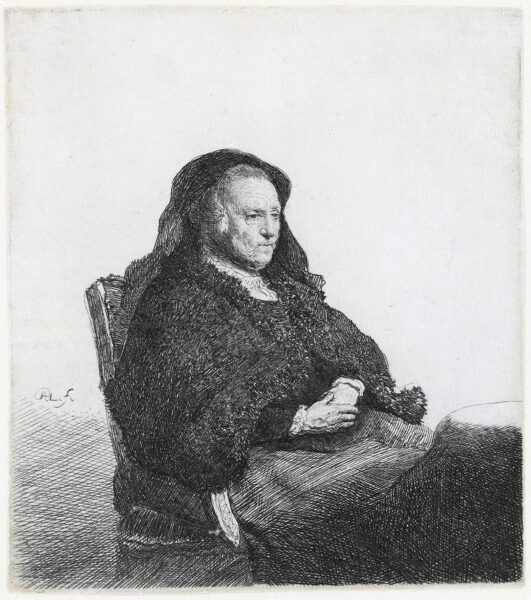“The Artist’s Mother seated at a Table, looking right: three Quarter Length”, c. 1631
etching: 15 x 13,2 cm;
signed in monogram centre left: RHL.f.
with narrow margins on all sides.
watermark fragment Strasbourg Bend (probably Hinterding A.a.)
"*" indicates required fields
Notes
During his lifetime, Rembrandt’s extraordinary skills as a printmaker were the main source of his international fame. Unlike his oil paintings, prints travelled light and were relatively cheap. For this reason, they soon became very popular with collectors not only within, but also beyond the borders of the Netherlands.
This portrait has long been identified as Rembrandt’s mother, Neeltgen Willemsdochter van Zuytbroeck (circa 1568-1640). The sitter appears in several etchings made between 1628 and 1632, and one of these plates (New Hollstein 87) listed in 1679 as Rembrandt’s moeder in the estate inventory of the Amsterdam print dealer Clement de Jonghe (see lots 100-102), who later owned a number of Rembrandt’s printing plates. Like other portraits of the period it has a certain formality which Rembrandt no doubt hoped would impress potential patrons, and in many respects it is more an elaborate study after a model than a conventional portrait. The old woman is shown in half-figure, facing to the right with her hands folded, seated in front of a low table. Her wrinkled face and hands are depicted in exquisite detail, framed by the dark headdress and fur-trimmed shawl. The artist probably drew her face, which is lightly bitten, from life directly onto the plate, and then added the more heavily etched headdress and rest of the figure later.
The etching must have been a commercial success since it was reprinted several times in the 1630’s and 40’s, and it was influential much beyond Rembrandt’s lifetime: over to centuries later, James McNeill Whistler (1834-1903) turned to the print for inspiration when he painted the famous portrait of his own mother (Musée d’Orsay, Paris), repeating the old woman’s pose and the starkness of the composition.
Literature
Bartsch 343; Hind 52;
The New Hollstein, 2013, no. 91
a fine impression of the second state (of three).
Plate not in existence – with Nowell-Usticke (1967): R
Provenance
- Unidentified, stamped letters SR(?) in an oval in brown ink (not in Lugt).
- Paul John Sperry (1934–2024), American lyric tenor, Chicago & New York;
- Christie’s London
- Private collection, The Netherlands





